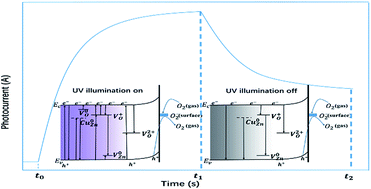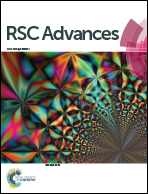Quantitative characterization of the long-term charge storage of a ZnO-based nanorod array film through persistent photoconductance†
Abstract
The persistent nature of the increased conductivity upon removal of incident illumination, described by the term persistent photoconductivity (PPC), in ZnO films is sensitive to their defect states. PPC can be viewed as a process of charge storage with relevant defects. To evaluate charge storage quantitatively, in this work, some thought-provoking characteristic quantities were derived from a photocurrent–time curve acquired by testing the photoelectric properties of ZnO under on and off UV illumination. Quo was defined as the obtained charge number per unit voltage during the light-on phase, while Qus was defined as the storage charge number during the light-off phase. η was acquired by dividing Qus by Quo to measure the storage efficiency after the removal of UV light. On the basis of previous work, it was assumed that the PPC of ZnO originated from the unique property of V0O. Meanwhile, this report reveals that the intrinsic defects VO2+, VO+, V0Zn will enhance Quo and Qus but decrease η in the pure ZnO nanorod array film. The extrinsic defect Cu0Zn introduced by coating the ZnO nanorod array film in an ethanol solution of copper acetate suppresses Quo and Qus but promotes the increase of η. Since the whole methodology originated from a series of physical definitions, it can be easily extended to other materials with similar PPC effects.



 Please wait while we load your content...
Please wait while we load your content...